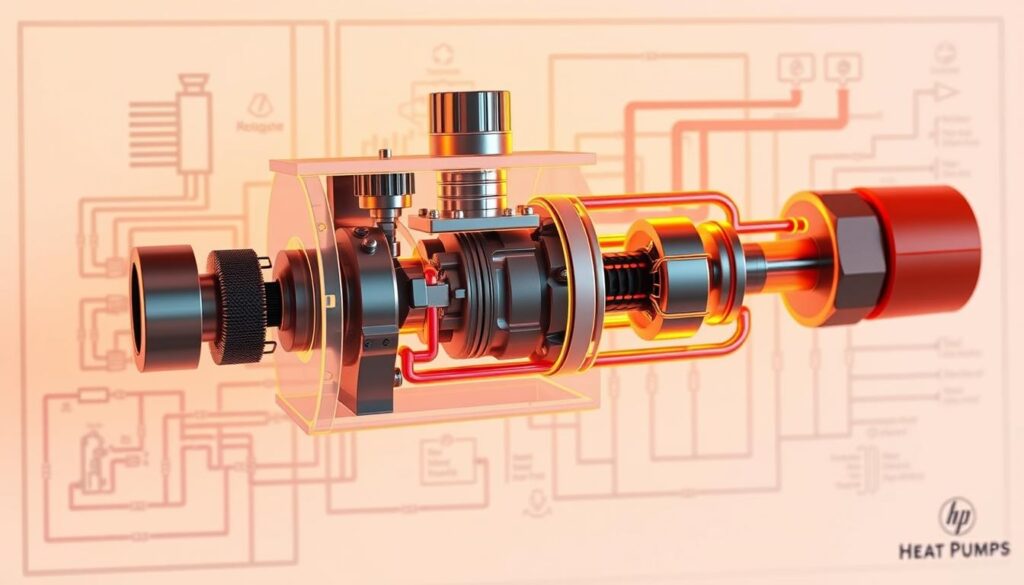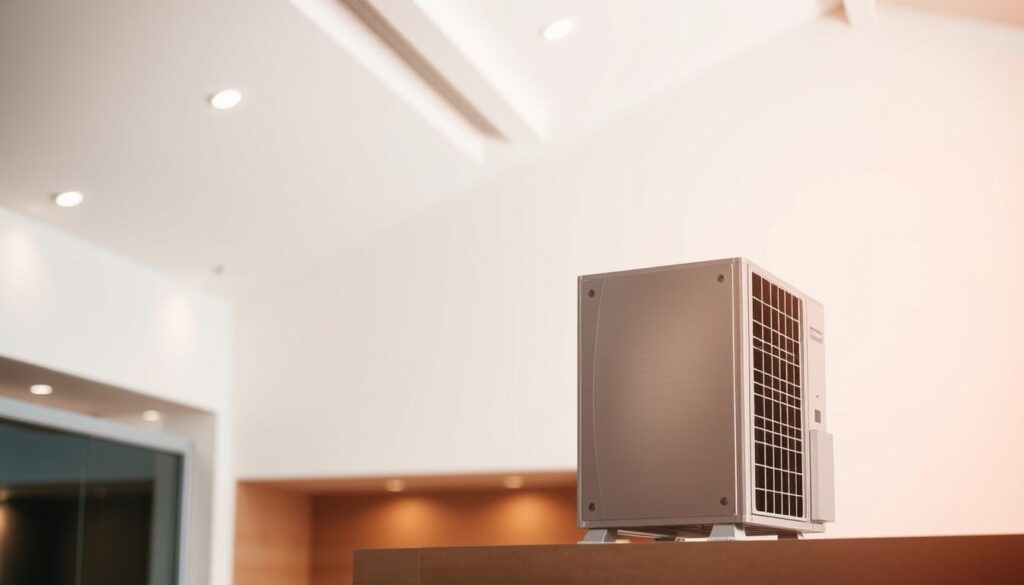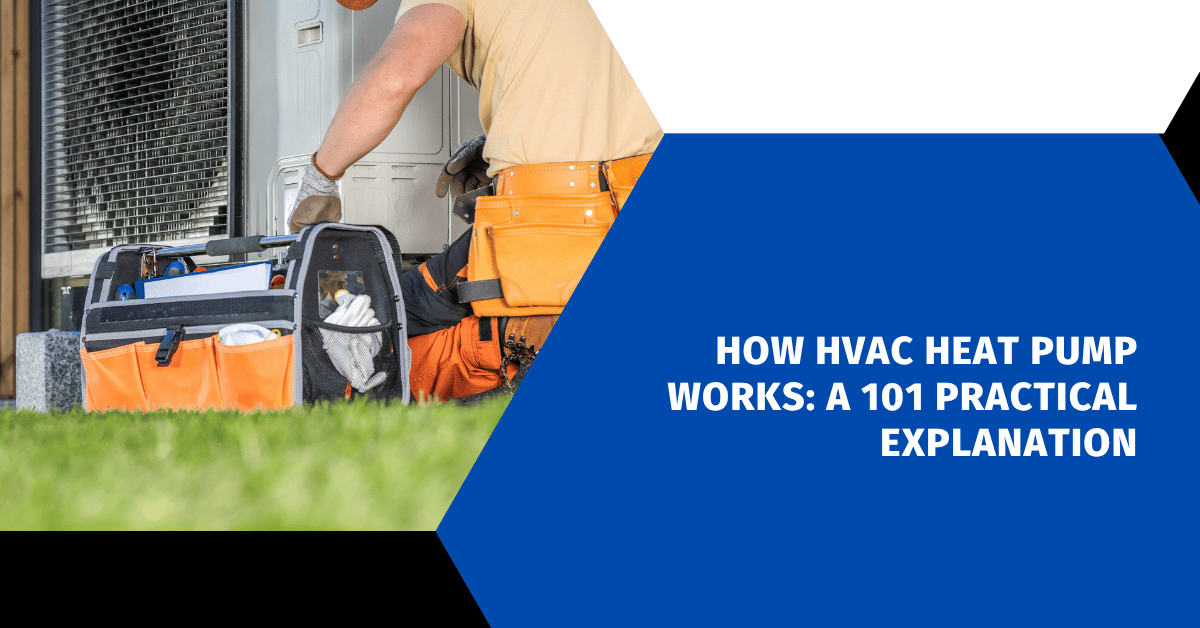Affiliate Disclosure
HVAC Guide Guys is a participant in the Amazon Services LLC Associates Program, an affiliate advertising program designed to provide a means for sites to earn advertising fees by advertising and linking to Amazon.
How HVAC Heat Pump Works? Ever wondered how one system can both heat and cool your home? It uses less energy than old heating methods. The secret is HVAC heat pumps, a new way to keep your home comfy and save energy.

HVAC heat pumps work like a big refrigerator. They move heat, not make it, which is very efficient. Unlike old heaters that burn fuel, these systems take heat from outside air or ground and bring it inside.
The main idea behind HVAC heat pumps is simple. Heat moves from warm to cold areas naturally. With a little electricity, they can reverse this, bringing warmth from outside into your home.
Key Takeaways
- Heat pumps can both heat and cool your home efficiently
- They move heat instead of generating it from scratch
- HVAC heat pump technology uses minimal electricity
- Systems work effectively in various climate conditions
- Heat pumps improve indoor air quality
Table of Contents
Understanding the Basic Principles of Heat Transfer
Heat transfer is a fascinating process at the heart of heat pump technology. It shows how energy moves naturally. This knowledge helps us see the smart design of today’s heat pump systems.
To talk about heat pump efficiency, we must understand how heat moves. Heat naturally flows from warm to cool areas. But, heat pumps can do the opposite with clever engineering.
Natural Heat Flow and Energy Movement
The science of heat transfer shows three main ways heat moves:
- Conduction: Direct heat transfer through solid materials
- Convection: Heat movement through fluids and gases
- Radiation: Heat transfer through electromagnetic waves
The Science Behind Temperature Differences
Heat pump installation uses temperature differences. Think of heat energy like water flowing downhill – it naturally moves from higher to lower temperatures. Heat pumps create artificial differences to move heat against its natural flow.
Heat Energy Extraction Process
| Heat Transfer Method | Efficiency | Common Applications |
|---|---|---|
| Conduction | 80-90% | Metal heat exchangers |
| Convection | 70-85% | Air and liquid systems |
| Radiation | 30-50% | Infrared heating |
“Heat pumps transform energy movement from a challenge into an opportunity.” – HVAC Engineering Insights
By understanding these principles, we see how heat pumps efficiently move thermal energy. They are a leading solution for today’s heating and cooling needs.
Explore Our HVAC Shop
Looking for top-rated HVAC tools, parts, and accessories? Visit our shop and find the perfect solution for your needs.
Visit the ShopHow HVAC Heat Pumps Work: Core Components and Operation
An HVAC heat pump is a complex system for controlling temperature. At its core is the heat pump compressor. It drives the refrigeration cycle, making it possible to heat and cool.
Your heat pump has key parts that work together:
- Outdoor unit with heat exchanger
- Indoor air handler
- Heat pump compressor
- Heat pump refrigerant lines
- Reversing valve
The heat pump refrigerant is vital. It moves thermal energy between inside and outside. This process helps control temperature.
A well-designed heat pump can achieve temperature differences of 10° to 15°F. This makes it much more efficient than old heating systems.
Important features include:
| Component | Primary Function |
|---|---|
| Compressor | Circulates refrigerant and creates pressure changes |
| Reversing Valve | Switches between heating and cooling modes |
| Expansion Valve | Regulates refrigerant flow and temperature |
Today’s heat pumps aim for comfort and energy savings. They use smart control systems for precise temperature control. This also cuts down on energy use.
Explore Our HVAC Shop
Looking for top-rated HVAC tools, parts, and accessories? Visit our shop and find the perfect solution for your needs.
Visit the ShopThe Heat Pump Refrigeration Cycle Explained
Understanding the heat pump refrigeration cycle is key to seeing how these systems work. Your heat pump outdoor unit is vital in this process. It helps manage energy and transfer heat.
The cycle has four main stages. These stages change the refrigerant, allowing for heating or cooling. Let’s dive into how this system operates:
Refrigerant State Transformation
The cycle starts with the heat pump reversing valve controlling refrigerant flow. This special part makes the system switch between heating and cooling easily.
- Refrigerant changes between liquid and gas states
- Energy is transferred through phase changes
- Heat is either absorbed or released during each stage
Key Cycle Stages
Each stage of the refrigeration cycle has a specific role in moving thermal energy:
- Evaporation Phase: Low-pressure liquid refrigerant absorbs heat
- Compression Process: Refrigerant is pressurized and heated
- Condensation Stage: Heat is released to the surrounding environment
- Expansion Valve Function: Pressure is reduced, cooling the refrigerant
Performance Characteristics
| Cycle Parameter | Typical Value |
|---|---|
| Coefficient of Performance (COP) | 3 to 5 |
| Refrigerant Types | R32, R290 |
| Energy Efficiency | 250% to 400% |
“The refrigeration cycle transforms thermal energy through an elegant dance of pressure and temperature changes.” – HVAC Engineering Insights
Your heat pump’s efficiency in moving heat depends on this precise cycle. It makes your heat pump a powerful and versatile climate control solution.
Types of Heat Pump Systems for Residential Use
Exploring heat pump options for your home reveals many modern systems. They are designed to keep your home comfortable all year. These systems use advanced technology to efficiently control indoor temperatures.
The main types of heat pump systems for homes include:
- Air-Source Heat Pumps: Most common residential solution
- Geothermal Heat Pumps: Underground temperature-based systems
- Ductless Mini-Split Systems: Flexible heating and cooling options
- Hybrid Heat Pump Systems: Integrated with traditional heating sources
Air-source heat pumps are the top choice for many homeowners. They work by moving heat between inside and outside. Thanks to new tech, they can even work in temperatures as low as 5°F.
Modern heat pumps represent a game-changing approach to home temperature management.
Geothermal heat pumps are very energy-efficient. They cost more to install but save money over time. These systems use the stable temperatures underground for heating and cooling.
Ductless mini-split systems are great for homes without ducts. They offer precise heating and cooling. This makes them perfect for adding rooms or renovating homes with special designs.
The federal Inflation Reduction Act and utility programs now offer big incentives for heat pumps. This makes them more affordable than ever.
Explore Our HVAC Shop
Looking for top-rated HVAC tools, parts, and accessories? Visit our shop and find the perfect solution for your needs.
Visit the ShopHeat Pump Efficiency and Performance Metrics
Knowing how efficient heat pump systems are is key for homeowners wanting to save energy. Today’s heat pumps save a lot of energy and money.
Coefficient of Performance (COP)
The Coefficient of Performance is a key measure of heat pump efficiency. A typical home heat pump has a COP of about four. This means it makes four units of heat for every unit of electricity it uses.
- Higher COP values mean better heating efficiency
- Performance changes with temperature
- It shows the ratio of heat output to energy used
Energy Efficiency Ratings
When looking at heat pump parts, two main ratings are important:
| Rating | Range | Significance |
|---|---|---|
| SEER | 14-25 | Cooling efficiency in summer |
| HSPF | 8-10 | Heating performance in cold weather |
Seasonal Performance Factors
Heat pump efficiency is influenced by several things:
- Climate conditions
- Professional installation
- Regular maintenance
- Smart thermostat use
Good installation can boost efficiency by almost 30%.
Choosing a heat pump with high efficiency ratings can save a lot of energy and money. It also helps the environment over time.
Reversible Operation: Heating and Cooling Modes

Your heat pump’s versatility comes from a special part called the heat pump reversing valve. This amazing device lets your HVAC system easily switch between heating and cooling. It keeps your home comfortable all year round.
The heat pump’s magic is in its ability to change the flow of refrigerant. In heating mode, it pulls warmth from outside air and moves it inside. When it’s hot outside, the system flips to cooling mode. It then takes heat from inside and sends it outside.
- The reversing valve has four key ports that connect to:
- Compressor
- Indoor coil
- Outdoor coil
- Expansion valve
- A bad reversing valve can cut system efficiency by 20-30%
- Working right, the valve helps save energy
“The reversing valve is the heart of a heat pump’s ability to provide both heating and cooling efficiently.” – HVAC Engineering Experts
Keeping your heat pump in top shape is important. Regular checks by pros can stop problems with the reversing valve. This ensures your system keeps your home at the right temperature all year.
Heat pumps are super efficient, with rates up to 200% to 400%. They’re a great way to stay cozy while saving on energy costs.
Explore Our HVAC Shop
Looking for top-rated HVAC tools, parts, and accessories? Visit our shop and find the perfect solution for your needs.
Visit the ShopCold Climate Heat Pump Technology
When it gets really cold, your home’s heating system really has to work hard. Cold climate heat pump technology has changed how we keep our homes warm and energy-efficient in cold areas.
Today’s heat pump installation methods work much better in freezing temperatures. These systems are made to pull heat from the air, even when it’s very cold outside.
Advanced Features for Sub-Zero Operations
Cold climate heat pumps have amazing features:
- They work well even when it’s as cold as 5 degrees Fahrenheit.
- They use variable-speed compressors for better temperature control.
- They have advanced vapor injection technology.
Defrosting Mechanisms
It’s important to stop ice from building up on heat pumps. Now, they have:
- Smart defrost cycles.
- Automatic sensors that start defrosting when needed.
- Quick ways to spread heat around.
Backup Heating Solutions
In very cold weather, heat pumps use backup heating:
| Backup System | Temperature Range | Efficiency |
|---|---|---|
| Electric Resistance Heating | Below 5°F | 70-80% effective |
| Dual Fuel Systems | -20°F to 5°F | 90-95% effective |
*Cold climate heat pumps can reduce carbon emissions while maintaining home comfort in extreme temperatures.*
With up to $2,000 in federal tax credits and energy savings of 40% over old systems, getting a cold climate heat pump is a wise choice for today’s homeowners.
Modern Heat Pump Innovations and Features

Heat pump technology has changed home comfort in big ways. It brings new efficiency and smart features. These changes make heating and cooling your home better than ever.
Some key innovations in heat pump tech include:
- Smart integration with home automation systems
- Variable-speed compressors for better efficiency
- Advanced refrigerants that are kinder to the environment
- Intelligent temperature zoning
Modern heat pumps can cut down electricity use for heating by up to 75%. They work at different speeds to use less energy. This means they can control temperature better and save on energy costs.
“The future of home comfort is smart, efficient, and environmentally conscious.” – HVAC Technology Experts
Hybrid heat pump systems offer a lot of flexibility. They can:
- Work with traditional heating methods
- Connect to hot water tanks for clean water
- Integrate with smart home tech
- Control temperature in different zones
Cold climate heat pumps are also impressive. They work well even when it’s as cold as 5°F. Thanks to new defrost systems and smart ice-detection, they keep performing well in winter.
These tech advancements can help your home. They might lower energy bills, reduce environmental impact, and make your home more comfortable.
Conclusion
Learning about HVAC heat pumps shows a new way to heat and cool homes. These systems are very efficient, making up to three times more heat than they use. They use advanced tech, making them a green choice compared to old heating methods.
Heat pumps do more than just change the temperature. They come in different types, like mini-split units, and can fit into any home. They also help cut down CO2 emissions by 38%, which is great for the planet.
Heat pump tech keeps getting better, working well in all kinds of weather. New compressors and variable-speed features save energy. Plus, there are grants and rebates to help you get one. Heat pumps are key to making homes more eco-friendly and comfortable.
Exploring heat pump technology opens up new ways to save energy at home. By using these systems, you can make your home more comfortable, save money, and help the environment. It’s a step towards a greener future for our homes.

